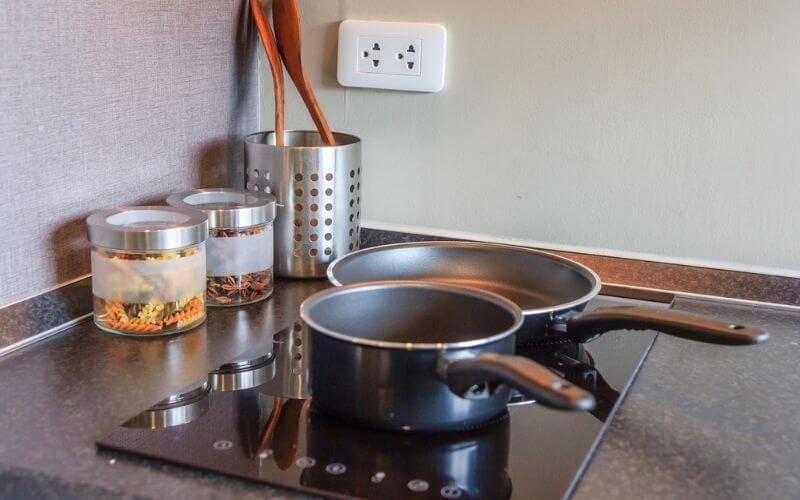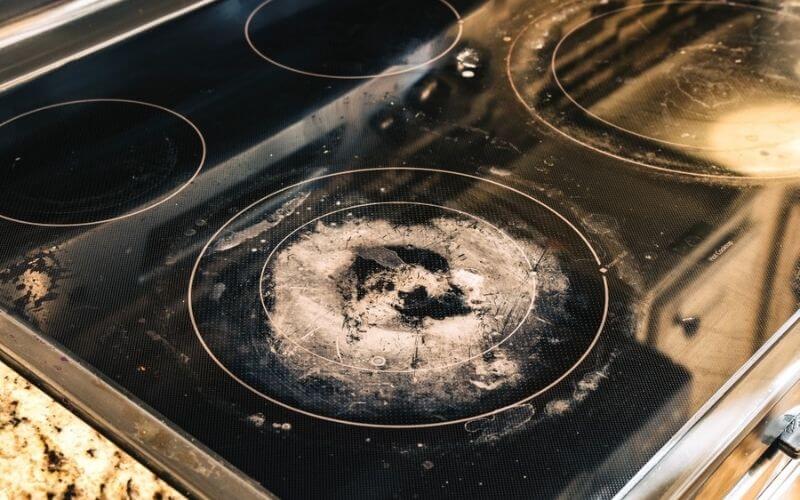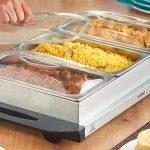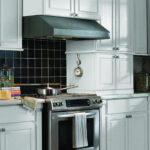Have you ever been excited to use a new glass cooktop, only to have it crack under a heavy pot or cast-iron skillet? The use of cast iron on glass cooktop surfaces can spell disaster, especially if you aren’t careful.
If you just bought a new stove with a glass cooktop, and own lots of cast iron pots and pans, don’t despair. Using cast iron on a glass top stove can be done safely and we’ll show you just how. This article will look at how to protect glass top stove from cast iron equipment.
Why is it important to protect your glass top stove?
Glass top stoves are becoming increasingly popular in modern kitchens due to their sleek and stylish appearance, even heating, and ease of cleaning. However, they are delicate and prone to scratches, chips, and cracks.
The cost of replacing a damaged glass top stove can be significant, making it crucial to take precautions to protect it from damage.
The Risks of Using Cast Iron Cookware on Glass Top Stoves
1. Scratches and Chips
The rough and heavy surface of cast iron cookware can easily scratch or chip the glass surface of a glass top stove. This damage is not only unsightly but can also lead to further problems like cracking and even complete failure of the stove.
Scratches and chips can also trap dirt and debris, making it more challenging to clean the surface and increasing the risk of further damage.
2. Thermal Shock
Cast iron cookware is known for its ability to retain heat for a long time. However, this can be dangerous when used on a glass top stove. Sudden changes in temperature, such as placing a hot cast iron pan on a cold stove, can cause the glass to crack due to thermal shock.
The thermal shock can also cause uneven heating of the glass top stove, leading to further damage.
How to Protect Glass Top Stove from Cast Iron Pans

Cast iron cookware is heavy-duty and can be rough on your stovetop and counters. These steps will help you safely use cast iron on an electric stove and cooktops. When followed carefully, you won’t have to replace a glass stovetop every few months!
1. Use a Heat Diffuser
A heat diffuser is a device that helps distribute heat evenly and prevents hot spots. It is especially useful when cooking with cast iron cookware on a glass top stove. Place the heat diffuser on the stove, then place the cast iron pot or pan on top of the diffuser. This will help distribute the heat more evenly and prevent direct contact between the cast iron cookware and the glass top stove.
2. Use a Protective Mat or Trivet
Another way to protect your glass top stove from cast iron cookware is to use a protective mat or trivet. Place the mat or trivet on the stove, then
place the cast iron pot or pan on top of it. This will help prevent direct contact between the cast iron cookware and the glass top stove and reduce the risk of scratches or damage.
3. Lift and Move Cookware Carefully
When using cast iron cookware on a glass top stove, it is crucial to lift and move the cookware carefully. Do not slide or drag the cookware on the stove surface, as this can scratch or chip the glass. Instead, lift the cookware and move it gently.
4. Keep the Stovetop Clean and Free of Debris
A clean stovetop is essential for preventing scratches and damage to the glass top. Use a soft cloth or sponge to wipe away any spills or debris immediately. Avoid using abrasive cleaners or scrubbers, which can scratch the surface.
5. Use Cookware with Smooth and Flat Bottoms
When purchasing cast iron cookware for use on a glass top stove, look for cookware with smooth and flat bottoms. Avoid cookware with rough or uneven bottoms, as they can scratch or damage the glass top. Smooth and flat bottomed cookware will provide more even heat distribution and reduce the risk of damage to the stove.
6. Avoid Dragging Cookware on the Stovetop
As mentioned earlier, it is essential to avoid dragging or sliding cast iron cookware on the glass top stove. Always lift the cookware and move it gently to prevent scratching or chipping of the glass surface.
7. Be Mindful of Temperature Changes
Cast iron cookware retains heat for a long time, and sudden changes in temperature can cause the glass top stove to crack due to thermal shock. Therefore, it is essential to be mindful of temperature changes when cooking with cast iron on a glass top stove. Allow the cookware to cool down before placing it on the glass top stove, and avoid placing cold cast iron cookware on a hot stove.
8. Choose Cookware with Rounded Edges
Cookware with sharp edges, such as skillets, can scratch the glass top stove. To avoid this, choose cookware with rounded edges. This will reduce the risk of scratches and chips on the glass surface of the stove.
9. Use Smaller Cookware
Using smaller cookware can also help protect your glass top stove from damage. Smaller pots and pans are lighter, making them easier to lift and move carefully. They also distribute heat more evenly, reducing the risk of hot spots and thermal shock.
Protecting Glass Top Stove from Scratches

Here are a few things you can do to prevent and remove scratches from your glass cooktop:
- Use a cooktop protector mat and change it when it is worn out. It is also important to clean these covers once a week, or after a hectic and substantial cooking session.
- Don’t slide your pots and pans back and forth along your stove. Lift them away and set them down gently instead.
- Use lightweight pots and stainless-steel cookware whenever possible.
- Scrub the bottom of your pots and pans regularly and remove the grease and burnt bits of food there.
- Clean spills right away and never use steel wool and metal sponges on your glass cooktop.
- Avoid using aluminum foil on these kinds of stoves as they can leave marks and scratches on the delicate cooking surface.
- To fix small scratches, make a paste from baking soda and water and gently buff away the scratch with this mixture. Make sure the paste is wet and rubbing dry baking soda will make the damage worse.
- To keep your glass cooking surface looking new, use glass cleaner to keep things clean and shiny.
- Follow manufacturer’s instructions when using and cleaning your stove and cookware.
- Regularly season the entire surface of your cast iron cookware. You should also use newer versions of cast iron skillets as these have much smoother bottoms than older ones.
- Avoid using cookware with round bottoms as they cause scratches. Instead, use pots and pans with smooth and flat bottoms, as they are more stable and will shift around less, reducing the chances of scratching up your glass cooktop.
Strategies to Clean Glass Stove Tops
Want to know the easiest way to clean your glass cooktop using things already in your pantry? We’ve got you covered!
What You Need:
- Baking soda
- A spray bottle of white vinegar diluted with water
- A soft cloth or rag
Instructions:
- Spritz it with the vinegar solution.
- Wipe the liquid away with the cloth.
- Buff any streaks out with a dry cloth.
- For a deeper clean, spray the vinegar onto the surface and then sprinkle some baking soda over the surface.
- Dip a towel into some hot water and squeeze out the excess. Lay the towel over the cooktop and leave it there for 10-15 minutes.
- Then, wipe away the baking soda/vinegar mixture with a cloth. If needed, spray vinegar again and buff out any streaks with the cloth.
Not into home remedies? Use these products instead, as they are the finest cleaning solutions for glass cooktops.
- Weiman Ceramic and Glass Cooktop Cleaner: This cleaner is mild, yet powerful. It gets rid of grease and grime easily, without wearing down the glass surface. It is also biodegradable and adds shine and polish to your stove.
- Cerama Bryte Cooktop Cleaning Kit: If you need a cleaner for stubborn dirt and buildup, this is the one to get the job done. It combines heavy duty cleaning with gentle and non-scratch properties that won’t further damage your stove surface.
- Bar Keepers Friend Ceramic & Glass Cooktop Cleaner: Like vinegar, this is an acid-based cleaner and works to clean stains and grime without scratching the glass surface. It is good enough to remove hardened and burnt bits of food and residue and works quickly.
Things to bear in mind when cleaning glass stove top surfaces:
- Only clean your stovetop when it is completely cool.
- Don’t use too much of the cleaning product.
- Use gentle tools like soft cloths instead of steel wool or a scouring pad.
- Follow the manufacturer’s instructions when cleaning your stove.
Follow This to Maintain Your Glass Top Stove
To keep your glass top stove looking new and sleek for longer, follow these steps:
- Avoid using very heavy cookware and instead, use things like copper and stainless steel.
- Use newer versions of cast iron skillets that have a smoother surface.
- Do not use round bottom pans or woks.
- Clean any messes immediately, before they have a chance to harden or burn on the stove surface.
- Wipe down your stove after each use and deep clean the cooktop once a week on a schedule.
Frequently Asked Questions
Below you’ll find answers to questions we get asked the most about protecting glass top stoves from cast iron.
01. Can I Use Cast Iron Cookware on a Glass Top Stove?
While it is recommended against using cast iron skillets on glass cooktops, you can cook with them as long as this is done carefully.
02. Can I Use a Cast Iron Skillet on a Ceramic Cooktop?
Cast iron can leave scratches on ceramic cooktops so it is generally best to avoid using them on more delicate stove surfaces.
03. How Do I Fix Black Glass Top Stove Discoloration?
Using a baking soda paste will remove discoloration and clean marks and spots on glass top stoves.
04. How Do I Prevent Stains on Glass Cooktops?
Cleaning up spills and oil splatter immediately prevents stains and discoloration from ruining glass top stoves.
05. Can I use cast iron cookware on a glass top stove?
Yes, you can use cast iron cookware on a glass top stove, but it requires some precautions and care to avoid damage to the stove.
06. Can cast iron cookware scratch a glass top stove?
Yes, cast iron cookware can scratch or chip the glass top stove if not used carefully. It is essential to use a heat diffuser or protective mat, lift and move cookware carefully, keep the stovetop clean, and use cookware with smooth and flat bottoms to avoid damage.
07. How do I clean my glass top stove after using cast iron cookware?
Use a soft cloth or sponge to wipe away any spills or debris immediately. Avoid using abrasive cleaners or scrubbers, which can scratch the surface.
08. Can I use a cast iron grill pan on a glass top stove?
Yes, you can use a cast iron grill pan on a glass top stove, but it requires the same precautions and care as using other cast iron cookware.
09. What should I do if I accidentally damage my glass top stove with cast iron cookware?
If you accidentally damage your glass top stove with cast iron cookware, stop using it immediately and contact a professional for repair or replacement options. Continuing to use
Conclusion
It is always disappointing to see your shiny new glass top stove become scratched or grimy. If you’ve invested in both a new stove and a cast iron cookware set, this article will tell you how to protect a glass top stove from cast iron.
These steps will protect your stovetop from cracks and scratches, and lengthen the lifespan of your stove. Follow the guidelines mentioned to get the best of both worlds in the kitchen. Happy cooking!






